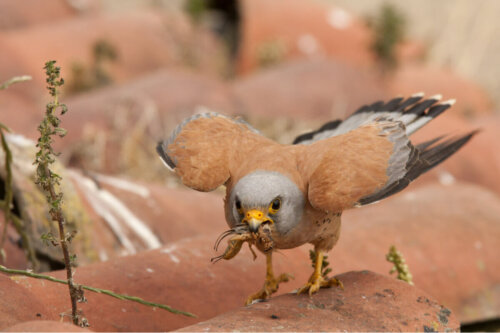Lesser Kestrel, the Smallest of the Falcons


Written and verified by the biologist Miguel Mata Gallego
The lesser kestrel is a beautiful insectivorous bird that was once easy to find in the European countryside. It’s often associated with pigeon lofts, towers, and abandoned buildings. However, its population fell rapidly a century ago due to human intervention.
Today, conservation efforts and the installation of artificial nesting boxes have considerably improved its situation but it still has some major problems. Today we’ll tell you about the characteristics of this small diurnal raptor: what it eats, where it lives, and the conservation problems it’s currently experiencing.
The lesser kestrel: the smallest of the falcons
The lesser kestrel (Falco naumanni) is the smallest falcon species. This small falconiform bird has a wingspan of no more than 65 centimeters (25 inches) – and is often confused with the common kestrel. There are several characteristics of this bird, but these two stand out:
- The head and wing coverts of the males are bluish-gray and the breast is white or off-white with black spots. Unlike the common kestrel, the back is reddish-brown without spots.
- Females are similar, but their colors are duller, mainly reddish-brown, although they have the characteristic breast spots.
Diet of the lesser kestrel
This bird is a diurnal raptor that feeds mainly on insects. Its diet consists almost entirely of grasshoppers, crickets, and locusts. Occasionally, these birds also feed on small vertebrates, such as reptiles, amphibians, and rodents.
The lesser kestrel usually hunts in groups, in open areas where there are no trees. It usually swoops down from above, scanning the horizon over poles or dry trees in search of prey. Another hunting method used by this bird of prey is hovering. In fact, it hovers a few meters above the ground to stalk its victim, thanks to its powerful flapping.

Lesser kestrel, a country and colonial bird
The countryside is the habitat of the lesser kestrel and includes crops, steppes, and pastures with some diversity and elevated sites for hunting. It usually seeks agricultural areas with some biodiversity where there are plenty of tasty insects to eat.
In fact, the intensification of agriculture is one of the causes of the huge drop in their populations over the last decades.
Surely, one of the most remarkable characteristics of the lesser kestrel is its gregariousness. These animals form numerous colonies in the hollows of abandoned houses, bell towers, and other towers to raise their chicks.
Thus, it’s common to spot this bird in the bell towers or buildings of many rural villages, where the lesser kestrel is an attraction for birdwatchers. This bird is a clear example of rurality and native fauna at the same time.
A migratory bird
As for its distribution, the lesser kestrel is a migratory bird. Its breeding area is in Europe, where it spends the spring and summer forming colonies and hunting in the fields of the continent. In autumn, these birds undertake a migration to the warmer areas of the Sahel in Africa.
Even so, there are numerous specimens that remain in the Iberian Peninsula throughout the year. These cases are easier to see in the southern half of this region.
Conservation problems of the lesser kestrel
The main threat to this beautiful bird of prey is the loss of its feeding habitat. This is because agricultural intensification makes it increasingly difficult for it to find insects. Pesticides kill the populations of many invertebrates in the short and long term.
In addition, the lesser kestrel tends to nest in places such as dilapidated houses. Due to the loss of 95 % of its population during the 20th century, this species is now on the endangered list. There are plans for their recovery though.
A success for the lesser kestrel
Among the numerous conservation plans for the lesser kestrel, the most ambitious is the construction of building-like constructions with interior openings for these to nest in. These allow intensive monitoring of the colonies and of the health and welfare of the chicks.
In addition, these constructions are an enormous attraction for environmental education and tourism. In the community of Madrid, the native fauna rehabilitation association GREFA has built 12 of them. They’re currently using them to recover kestrel populations, while, at the same time, studying this species in depth.

A singular bird of prey that needs your help
Studies indicate that conservation efforts are being successful, as the population of lesser kestrels has increased from 5,000 pairs to 12,000. They’re still endangered though. Thus, we must continue to promote their nesting through the construction of boxes and other structures.
Likewise, the use of pesticides in agriculture is highly detrimental to this and other birds as it makes the insects on which they feed disappear. This is extremely detrimental to ecosystems and must be taken into consideration in the future.
All cited sources were thoroughly reviewed by our team to ensure their quality, reliability, currency, and validity. The bibliography of this article was considered reliable and of academic or scientific accuracy.
Colaboradores de Wikipedia. Falco naumanni [en línea]. Wikipedia, La enciclopedia libre, 2020 [fecha de consulta: 25 de febrero del 2021]. Disponible en <https://es.wikipedia.org/w/index.php?title=Falco_naumanni&oldid=124208482>.
Madroño, A., González, G. G., & Atienza, J. C. (Eds.). (2004). Libro rojo de las aves de España. Organismo autónomo parques nacionales.
https://www.grefa.org/proyectosgrefa/23-proyectos/cernicalo-primilla/red-de-primillares/2893-cernicalo-primilla-proyecto-qred-de-primillaresq
This text is provided for informational purposes only and does not replace consultation with a professional. If in doubt, consult your specialist.